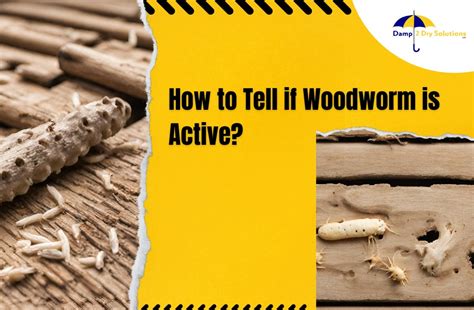How To Tell If Woodworm Is Active
Ronan Farrow
Apr 02, 2025 · 3 min read

Table of Contents
How to Tell if Woodworm is Active: A Comprehensive Guide
Woodworm infestations can be a homeowner's nightmare, causing significant structural damage if left unchecked. Knowing how to identify active woodworm infestations is crucial for preventing further damage and protecting your property's value. This guide provides a comprehensive overview of the signs of active woodworm and how to differentiate them from inactive infestations.
Key Signs of Active Woodworm Infestation
Several indicators can help you determine if a woodworm infestation is currently active. These signs go beyond simply seeing holes; they focus on evidence of recent activity.
1. Fresh Frass (Woodworm Droppings)
Frass, the sawdust-like excrement of woodworm larvae, is a critical indicator. Look for fine, powdery dust near holes in the wood. Active infestations will produce fresh frass that is:
- Light-colored: Older frass tends to darken with age and exposure to air.
- Loose and easily disturbed: If you brush it away and it quickly reappears, it's a strong sign of ongoing activity.
- Located near active exit holes: Fresh frass is usually found near recently created exit holes, indicating that larvae are still feeding and developing.
2. Active Exit Holes
The holes themselves can provide clues. While old holes might be discolored and surrounded by hardened frass, active exit holes are:
- Clean and sharp: They haven't been exposed to the elements for a long time, therefore appearing relatively smooth.
- Small and round: The size will depend on the type of woodworm, but they are generally small compared to older, larger, and more irregular holes.
3. Live Woodworm Larvae (Less Common but Definitive)
Although not always easily spotted, seeing a live larva is definitive proof of an active infestation. These are usually creamy-white, worm-like creatures that burrow within the wood. Finding these requires careful examination and sometimes involves probing suspect areas with a small, thin tool.
4. Tunneling Sounds
In some cases, you might be able to hear the larvae actively tunneling within the wood. This requires a quiet environment and a keen ear, but a faint clicking or scratching sound can indicate active feeding.
Differentiating Active from Inactive Infestations
It's crucial to distinguish between active and inactive infestations. An inactive infestation may involve old holes and darkened frass, but no live larvae or recent activity. This is less urgent than an active infestation.
Inactive Infestations:
- Darkened frass: Older frass is typically dark and compacted.
- Irregular, larger exit holes: These holes are often more significantly damaged and discolored by time and weathering.
- No fresh frass: The absence of fresh, light-colored frass suggests the infestation is inactive.
What to Do if You Suspect an Active Infestation
If you suspect an active woodworm infestation, it’s important to take action quickly. Contact a professional pest control company for a proper assessment and treatment. Ignoring an active infestation can lead to significant structural damage and costly repairs. Early detection and treatment are key to protecting your property.
Prevention is Key
Preventing woodworm infestations starts with maintaining a low-moisture environment in your home. Regular inspections, particularly in areas prone to moisture like bathrooms and kitchens, are also crucial.
By paying close attention to the signs mentioned above, you can effectively determine if you have an active woodworm problem and take the necessary steps to protect your home. Remember, early detection and professional treatment are vital for preventing widespread damage and preserving the structural integrity of your property.
Featured Posts
Also read the following articles
| Article Title | Date |
|---|---|
| How To Stop Citation To Discover Assets In Illinois | Apr 02, 2025 |
| How To Stop Dog Whining In Car | Apr 02, 2025 |
| How To Stop Rabbits From Eating Tulips | Apr 02, 2025 |
| How To Remove Fusion Extensions | Apr 02, 2025 |
| How To Sit On A Bike Saddle | Apr 02, 2025 |
Latest Posts
-
How Can I Find Out If A Motorcycle Is Stolen
Apr 03, 2025
-
How Can I Boost My Cell Signal In Rural Areas
Apr 03, 2025
-
How Can I Block Facebook On My Phone
Apr 03, 2025
-
How Can I Become A Midwife Assistant
Apr 03, 2025
-
How Can I Avoid Paying Nj Exit Tax
Apr 03, 2025
Thank you for visiting our website which covers about How To Tell If Woodworm Is Active . We hope the information provided has been useful to you. Feel free to contact us if you have any questions or need further assistance. See you next time and don't miss to bookmark.
